Counting Individual 41Ca Atoms with a Magneto-Optical Trap
Iain D. Moore,1 Kevin Bailey,1 Christopher Geppert,2 John P. Greene,1 Zheng-Tian Lu,1 Peter Mueller,1 Tom P. O�Connor,1 Klaus D.A. Wendt,2 Linda Young31Physics Division, Argonne National Lab; 2Johannes Gutenberg-Universit�t Mainz, Germany; 3Chemistry Division, Argonne National Lab
Motivation
| Calcium is one of the most abundant elements on earth and is of vital importance for the metabolism of biological organisms. Consequently, analysis of its long-lived radioisotope, 41Ca, has important applications in earth and life sciences. With a half-life of 1.03x105 years, 41Ca is a candidate for dating bones ranging from 50,000 to 1,000,000 years of age. This period is important in the study of early human development, and is beyond the reach of 14C-dating (t1/2 = 5730 years). Early Accelerator Mass Spectrometry (AMS) work indicated that 41Ca/Ca in different bone samples varied in the range 10-15 to 10-13. However, the natural abundance range is close to the detection limit of AMS and so these are more proof-of-principle measurements. | 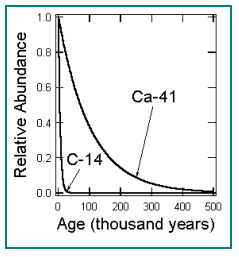 |
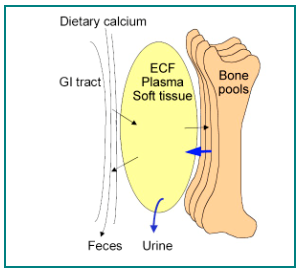 |
The use of deliberately enriched 41Ca for biomedical applications provides a direct method of monitoring bone loss and retention rates of human subjects in both research and diagnosis of osteoporosis. The long half-life of 41Ca translates into low specific radioactivity, and the isotope tracer can be safely introduced into subjects with an isotopic abundance in the range 10-13 to 10-8. The primary analytical sample for the nutritional study in this work was extracted from the urine of a number of subjects after they had been given a 100 nCi equivalent mass of 4x10-14g) dose of 41Ca. Urine samples were taken six days after ingestion up to later periods of 100 days and more. The Swiss Federal Institute of Technology (ETH) in Zurich chemically prepared these samples into the form of a 3M calcium nitrate solution and determined the amount of 40Ca present. A 10 ml drop of the solution contains ~ 1x1018 calcium atoms. |
Experimental Setup
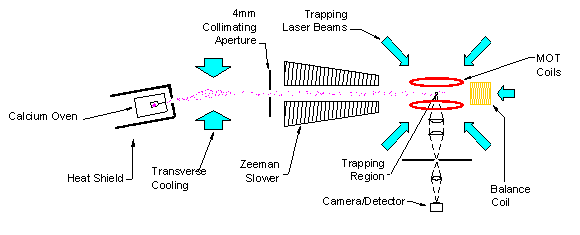
|
The Atom Trap Trace Analysis
technique is both extremely sensitive and selective, and is based on
the laser manipulation and detection of neutral atoms. This MOT system
operates on the 422.7 nm trapping transition in calcium. Atoms remain
trapped in a sub-millimeter region with an average lifetime of 18 ms,
limited by a relatively weak decay channel to an undesirable metastable
state. During the trap lifetime a single atom
scatters resonant photons at a rate of 3x106 s-1,
2.5% of which are imaged and counted by a photomultiplier detector with
an integration time of 8
ms.
|
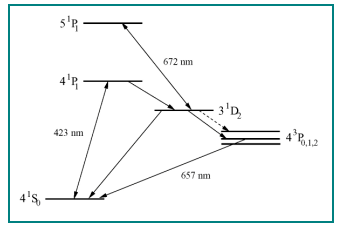 |
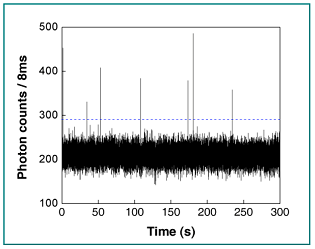 |
In order
to observe the rare isotope 41Ca, the system must be
sensitive enough to resolve and count single atoms. The figure to the
left shows a typical example of the raw data that indicates the
fluorescence of individual 41Ca atoms in the trap. A
threshold condition, indicated by the dashed line, of 5-sigma above the
mean of the background is required for an event to be accepted as a
single atom. |
Results
| In order to ensure that we have indeed detected 41Ca and not one of the abundant isotopes, we mapped out atom counts as a function of the laser frequency. For comparison the nearest stable isotopes 40Ca (96.9%), 42Ca (0.65%) and 43Ca (0.14%) were also trapped successively and are shown in the upper trace. The absence of counts on both sides of the 41Ca peak during the measurement duration of 6 h demonstrates that interference from the neighboring abundant isotopes is suppressed to below an isotopic abundance level of 7�10-10. | 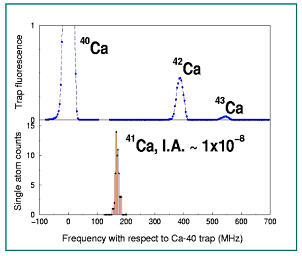 |
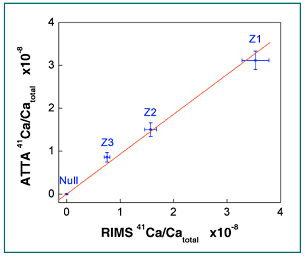 |
Three biomedical samples have been analyzed using ATTA and the results have been compared with those from RIMS (Resonance Ionization Mass Spectrometry) by the LARISSA group (Laser Resonance Ionization Spectroscopy for Selective Applications) of the Mainz University [1]. The linear correlation between the ATTA and RIMS values shown in Fig. 6b not only serves as a calibration of ATTA, but also demonstrates the validity of ATTA as a quantitative analysis tool. Within 1 hour of observation we can conclude that the 3-sigma detection limit on 41Ca/Ca reaches 4.5�10-10. |
This work is supported by the U.S. Department of Energy,Contract W-31-109-ENG-38
References
Counting individual 41Ca atoms with a Magneto-Optical Trap PRL Abstract / Preprint (physics/0310045)I. D. Moore, K. Bailey, J. Greene,
Z.-T. Lu, P. Mueller, T. P. O�Connor, Ch. Geppert, K. D. A. Wendt, L.
Young
Physical Review Letters 92,
153002 (2004)
Towards ultrahigh sensitivity analysis of 41Ca
I.D. Moore, K. Bailey, Z.-T. Lu, P.
Mueller, T.P. O'Connor, L. Young
Nuclear Instruments and Methods in
Physical Research B204, 701 (2003)
![[Argonne Logo]](/images/argonne_header_logo.jpg)
![[DOE Logo]](/images/header_doe.gif)